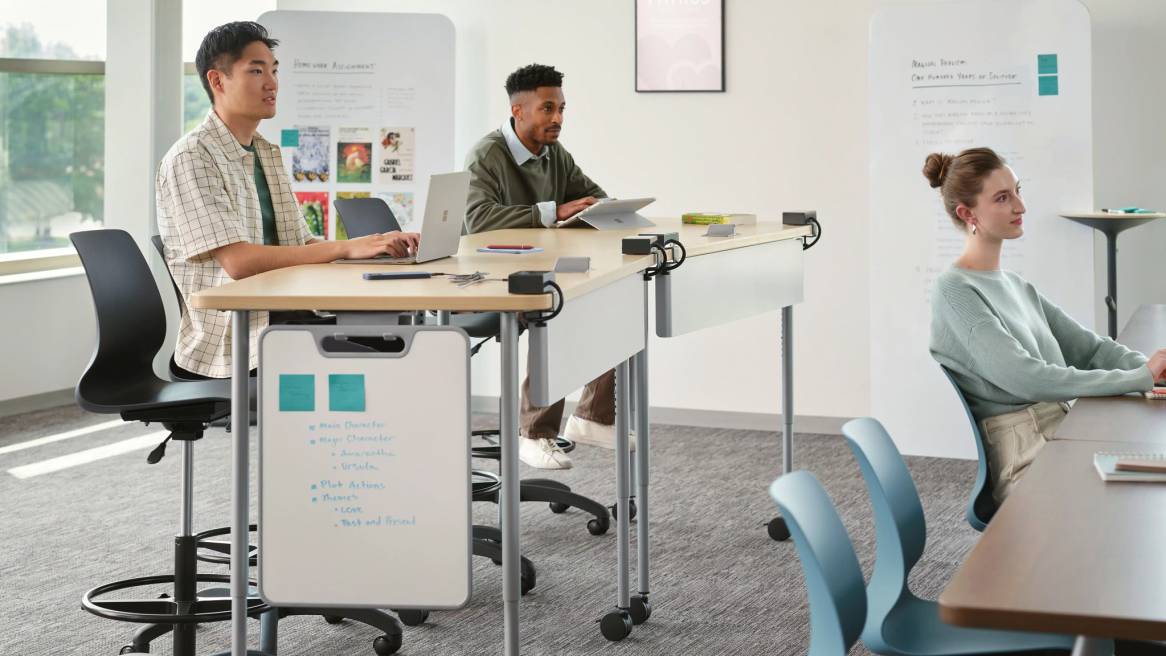Room to Learn
Understanding How UDL Can Address Barriers in Education
Research shows the way people learn is as unique as their fingerprints. Classrooms are highly diverse and curriculums need to be designed from the start to meet this diversity. But, when students struggle in the classroom the focus historically has been on the students’ perceived limitations. The study of neuroscience shifts the focus away from the students’ limitations and examines how the curriculum and environment are creating barriers to learning.
In our recent Steelcase Learning webinar, host Katie Pace, director of communications at Steelcase, spoke with three leading voices to better understand how the Universal Design for Learning (UDL) framework can address these barriers, improve the learning experience for all students and provide inspiration for the design of learning spaces.
Panelists:
Nicole Tucker-Smith, Founder + CEO, Lessoncast
David Reid, Principal, Multistudio
Marisa Sergnese, Applied Research and Learning Consultant, Steelcase Learning
Katie Pace: What are you hearing educators and leaders working in K-12 and higher education say their greatest challenge is today?
Nicole Tucker-Smith: The overwhelming thing that I hear is burnout. Feeling overwhelmed, feeling frustrated. Feeling tired. Educators go into education to make a difference and when they feel like they can’t make a difference, it really becomes heavy, and it leads to emotional burnout.
David Reid: There are a lot of big challenges, but one that spans across K-12 and higher education is adapting to the increasing range of individual needs among learners. This should have been recognized years ago. But the fact that it’s happening even more today is why UDL is gaining such popularity now, 25 years after its origins at Harvard. The number of students on the spectrum has been on the steady increase for years. So is the number of students with ADHD. More and more kids have individualized education plans. So it requires more resourcefulness from teachers today to provide differentiated learning. And this is leading to the burnout that Nicole talks about.
Marisa Sergnese: I would underline that school leaders are feeling a lot of pressure to balance that day-to-day. They’re overwhelmed with the number of tasks that they need to address regarding anything from disciplinary issues, absenteeism to inclusive curriculum design.
KP: The topic of Universal Design for Learning is getting a lot of attention, but it may not always be understood. Nicole, please help us define UDL.
NTS: Universal Design for Learning was inspired by universal design in architecture. For example, if we look at physical spaces where there may be stairs to an entry, we also need to provide access to individuals who may be using a wheelchair, so a ramp will be available as well. But that ramp isn’t for the exclusive use of someone who uses a wheelchair. That ramp can also benefit those who have a stroller or rolling luggage or a wheeling cart. The idea of universal design for learning is to think about who is most likely to be excluded or left out in a space that’s not fully accessible. It prompts designers and educators to ask, what are the on-ramps that a learner might need, a learner who may be on the autism spectrum, or someone who has ADHD or somebody who simply might be going through an emotional crisis? Then make that option available. When we make those options available, we normalize the reality that everyone needs something different.
The UDL framework has three principles that align to three neural networks. First, what do learners need in order to be engaged and recognize that every learner is going to need something different and even the same individual might be different on a given day – how do we design for multiple means of engagement?
The second principle is about designing for multiple means of representation. Representation is about connecting to how we perceive information and turn that into meaning. Think about a green and a red apple together. If I’m not familiar with an apple – the most I may be able to tell you is that it looks like fruit. But if I have background, knowledge and vocabulary, I could tell you they are two apples. I could tell you the green may be more tart, and the red apple may be sweeter. This is representation – to perceive information and turn it into meaning.
The third principle is designing for multiple means of action and expression. How do they navigate their learning spaces? How do they act and express themselves as they’re going through the learning journey? This is where we want to consider options for interaction. How are learners able to interact with one another, interact with any instruction that may be happening? How do learners express and communicate their ideas? Sometimes we get tied to everything having to be written down, but there are so many ways for learners to communicate.
KP: David, can you help viewers understand the difference between UDL and accessible design and universal design?
DR: Accessible design is often associated with ADA or the Americans with Disabilities Act. It’s incorporated into our building codes. It’s the law. We’re required to follow it. And it’s not just about accessibility for public buildings, but it’s about accessibility for employment, transportation communications and a host of other things. ADA has a lot in common with universal design, but generally universal design strives to be more comprehensive in providing accessibility and is more integrated into the architecture – everyone can navigate a building more comfortably when good universal design is in place. And this is true for UDL as well. UDL strives to make learning equitably accessible to every learner, whenever possible, having every learner participating in the same space. Whether you’re neurodiverse, or you have a visual impairment or dyslexia or dyscalculia – which is similar to dyslexia but associated with numbers – good UDL practices are going to help level the playing field and provide the support you need to overcome these learning barriers. It gives any learner in the room the same opportunities to be successful as a neurotypical learner. Learners do not have an isolated learning style, and there is no average brain. Every student is coming at the same learning challenge, but a little bit differently.
KP: Marisa can you help us understand where inclusive design fits into all of this.
MS: Inclusive design is a very powerful approach that aims to ensure every individual, regardless of their differences, can engage fully without any barriers. So inclusive design aligns really nicely with the UDL framework because it allows us to address human differences that are marginalized by standard designs.
Educators can build inclusive classrooms in many different ways – from changing up the physical space by lowering the lights, moving the classroom desks around … to things like making text to speech software available and having height-adjustable work surfaces.
KP: Nicole, what do you believe are some of the biggest barriers to learning today?
NTS: What teachers often say is that students just aren’t motivated. They’re not completing their programs. A UDL mindset reframes that idea: Instead of fixating on barriers within the learner or the student, we think about what may be barriers within the environment. So, instead of saying students aren’t motivated – we ask what might be barriers to motivation in our design of the learning environment and learning experience? When we do that, we as educators, as learning designers, even as architects, we’re taking back our agency.
+“We’re not blaming the individual. We’re thinking about how we can improve the environment to support that individual to fully thrive.”
Nicole Tucker-SmithFounder, CEO, Lessoncast
KP: David, what barriers have you seen that are creating challenges to learning?
DR: There are as many barriers as there are learners. What is a big barrier is to one student is a non-issue to another. The beauty of UDL is that it really builds a highly personalized approach to conveying learning to each individual student, and a robust UDL approach can make learning accessible for any number of learner variabilities. There are barriers related to cognitive variances or physical ability, variances related to trauma, sensitivities and socio-emotional variances, and so forth. We also look at positionalities of learners and how these affect inclusiveness and access to learning; things like gender and sexual identities, ethnic and racial identities, socio-economic identities or religious identities. These all affect how students are engaging in the classroom and ultimately affecting their ability to engage the learning in a way that’s successful. Barriers are going to look different from place to place and person to person. Community colleges admit 100% of their applicants, so they have a wide range of learner abilities. Compare that to a four-year, elite research institution that admits 20% of their applicants and there will still be learning barriers, and a broad spectrum of them, but they’ll look different from the barriers at the community college. So, we’ve got to be tuned in to where students are struggling and where students are thriving and try to help address those areas of struggle.
KP: Nicole, what are potential barriers to implementing UDL?
NTS: We have to think about implementing UDL on three levels. First, at the leadership level and understanding what systems and structures we need to have in place in order to support a UDL mindset. When I work with school districts and institutions of higher education, I tell them UDL is not about doing a new thing. It’s about re-envisioning the work they’re already doing. It’s about proactively removing barriers upfront, and that might take an investment in time. But you save time in the long run in avoiding what I call unproductive struggle. Then we think about determining the coaching level. Who’s going to support our implementers as they are applying a UDL framework? And then we also think about the instructors and the teachers, and the learners themselves.
KP: David, how are you helping educators think about the design of these learning environments and how they can support the success of the implementation of UDL?
DR: We’ve been working the last seven years to develop a resource that ties UDL to space design. We call it the Deck of Spaces – to help make the adoption of UDL simpler and, quite honestly, more fun. It’s a deck of 60 different idea cards that was designed in collaboration with educators and researchers associated with CAST, the original organization advancing and promoting UDL. The deck isn’t just about space design, it’s also about behaviors and teaching practices in the classroom. Each idea on each card has research citations that take you back to a bibliography so you can begin to learn more. The deck’s primary value is raising awareness of how space can impact various learners, by removing or imposing learning barriers.
“We’re not always cognizant of what space is doing to create a learning barrier.”
David ReidPrincipal, Multistudio
The cards can help people understand how space is a powerful behavioral model for the activities that we want to see in the classroom as part of UDL implementation. It’s the principle of space being “the third teacher.” A simple application of the card deck is having administrators and educators go through the deck and prioritize the top five to eight cards that might resolve teaching challenges they’re seeing in the classroom and begin to gain a familiarity with how space can positively impact the resolution of learning challenges via UDL principles.
KP: Marisa, can you share with us how the UDL framework impacts the design of learning environments?
MS: Understanding UDL has provided our team with another tool to approach active learning – which is focused on flexibility, movement and student engagement. UDL helps us focus on barriers and how we can design spaces that better support all students to thrive. For us, it’s about taking elements from the UDL framework and aligning them to specific design drivers so it can be very tangible and real for people.
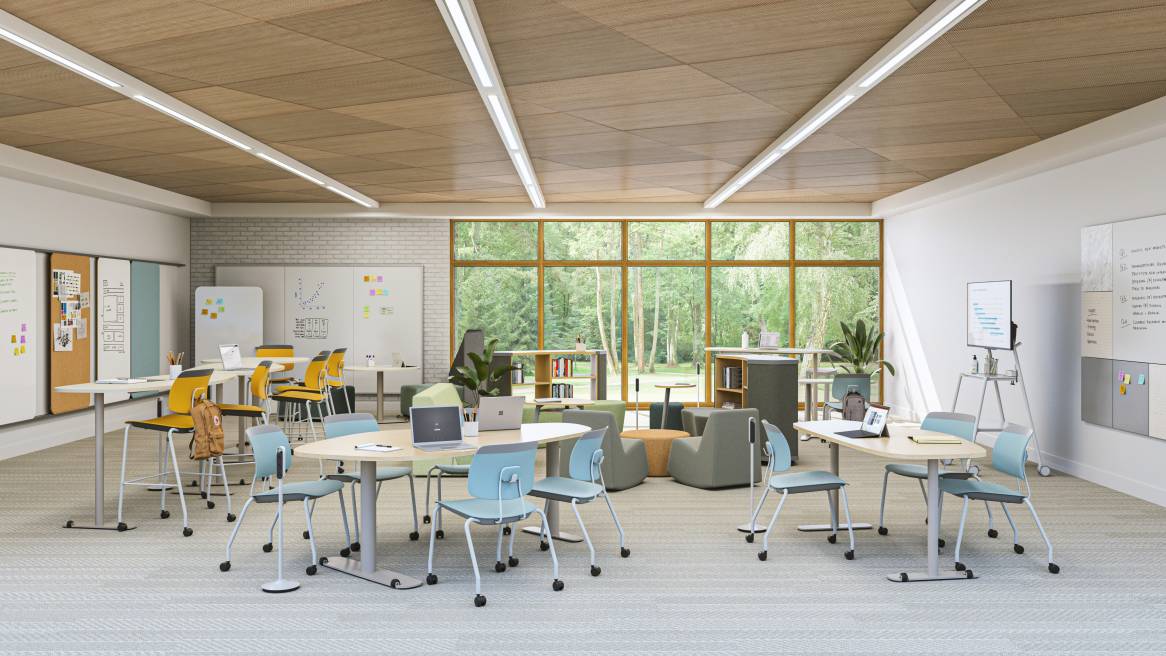
KP: David, what are some best practices you’ve encountered when working with schools trying to link UDL to space?
DR: Start by encouraging your teachers and educators to think about looking at UDL one learner at a time and gaining familiarity with opportunities to apply the principles of UDL. Pay attention to what barriers are being experienced and how you may address them. Secondly, help educators identify what UDL principles they might already be using. A lot of teachers are already doing things that are in alignment with UDL principles – but they haven’t tagged it with the UDL language. This realization takes some of the pressure off what can initially be perceived as a daunting new initiative. In terms of linking UDL to space – again we created the Deck of Spaces as a means of easy engagement. Use the deck of idea cards to problem-solve several different barriers you’re seeing in your school. This will help you gain a fluency in relating space design to UDL. Once you get more familiar with identifying design strategies to address learning barriers, I’d recommend doing an audit of all your classrooms and the broader school using this newly attained fluency. But start small, just like learning any new language, and build your competency gradually.
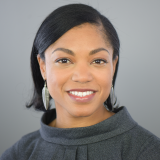
Nicole Tucker-Smith is the founder and CEO of Lessoncast, which helps schools implement professional learning initiatives focused on inclusive teaching and equity best practice. She is a global presenter on Universal Design for Learning and co-authored Supercharge Your Professional Learning: 40 Concrete Strategies to Improve Adult Learning, which provides practical how-to information for applying the UDL Guidelines to professional learning experiences.
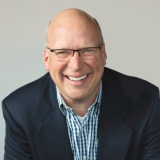
David Reid is a principal and education market leader at Multistudio, a national architecture and design firm. He is also co-founder of STEAM-Studio. His team has a deep focus on the science of learning, driven by Multistudio’s in-house Research Center and collaborative work with educators, anthropologists, psychologists and others.
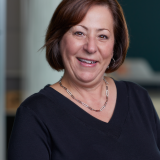
Marisa Sergnese is an applied research and learning consultant with Steelcase Learning. She has over 25 years of experience working in a variety of educational settings as a teacher, consultant, adjunct faculty member and school administrator.
ROOM TO LEARN:
Understanding UDL Can Address Barriers in Education
Watch our panel of experts from Lessoncast, Multistudio and Steelcase discuss how understanding and implementing a Universal Design for Learning framework can improve the learning experience for all students

